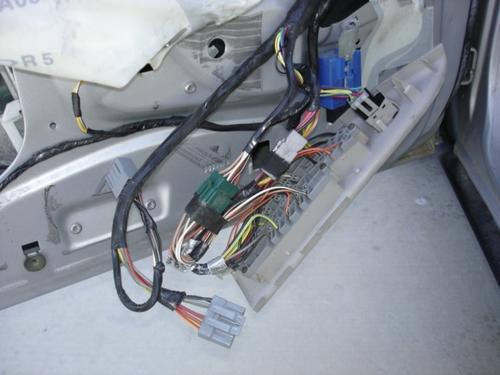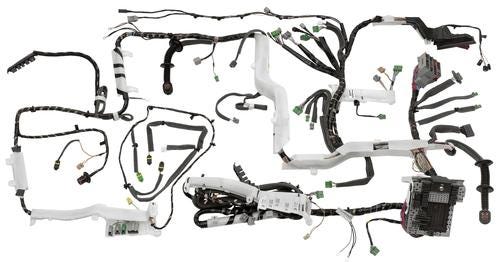My Mercury Wiring Harness Nightmare
September 13, 2011

Sometimes when I look at equipment, I wonder who had to design its wiring harnesses. It seems like a nightmare of a job, because signals go in so many directions, and wire bundles carry low-level analog signals, high-speed digital signals, several power lines, and ground.
When I attempted to replace a power-window motor on my '96 Mercury I uncovered an amazing nest of wires that controls windows, door locks, and mirror positions, In addition, the wiring connected to several other points within the door and to a small audio speaker I removed. The image below shows what I was up against.

The wiring surprised me for several reasons. The number of wires seemed excessive. Engineers saw the debut of the CAN bus in 1986, CAN-capable chips in '87, and the CAN 2.0 spec in '91, according to Wikipedia. It can take a long time for electronic innovations to appear in products such as automobiles and trucks, which require a long design cycle. But the door and lock controls seem like obvious places to reduce wiring. Someone once said that it takes a special engineer to reduce vehicle weight by five pounds, and if you can cut it by 10 pounds, you're a genius and a hero.
The image below shows a vehicle-wiring harness manufactured by Delphi. I can only guess at the weight, and I bet additional cables connect this harness to components. Lower voltages need heavier wires to deliver the same current as higher voltages with smaller wires. So, why haven't car manufacturers used 24-volt batteries and smaller cross-section wires? Perhaps the cost of a larger battery and its weight don't offset the weight reduction. In either case, someone still must run a wiring harness, although a lighter one in a 24-volt vehicle.

The wiring harness involved many connectors -- again, not all shown in my first image. Manufacturers must allow buyers choices of options, which means a variety of controls on door arm rests, front-panel consoles, and entertainment equipment. So some connectors remain "open" and unused. Given the harsh environment inside a vehicle door -- dirt, water, salt, and other chemicals -- the connectors looked good and had clean contacts. Good engineering there. The connectors were difficult to separate, which is good for reliability, but difficult for DIY repairs like mine. Perhaps there's a special tool to unlatch connectors. I'd rather have robust than easily separated connectors, though.
I haven't had a chance to look at a wiring harness in a late-model car, but hope engineers have taken advantage of CAN bus and LIN technologies to simplify wiring harnesses. They must face formidable challenges when they design them, even when they use design tools such as Capital and VeSys from Mentor Graphics. And the engineers must accommodate a variety of modifications for different vehicle models as well as conform with safety specifications. I salute any engineer who designs wiring harnesses. They have one of the most difficult professions.
P.S. Because the glass jammed in my car door, it proved impossible to replace the window motor without taking the Mercury to a dealer and spending $300 or more for a new motor and labor. Given the age of the car and its 182,000 miles, I donated it to a local charity.
About the Author(s)
You May Also Like



